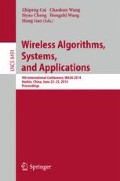Abstract
Recent years, the studies of link prediction have been overwhelmingly emphasizing on undirected networks. Compared with it, how to identify missing and spurious interactions in directed networks has received less attention and still is not well understood. In this paper, we make use of classical link prediction indices for undirected networks, adapt them to directed version which could predict both the existence and direction of an arc between two nodes, and investigate their prediction ability on six real-world directed networks. Experimental results demonstrate that those modified indices perform quite well in directed networks. Compared with Bi-fan predictor, some of them can provide more accurate predictions.
Access this chapter
Tax calculation will be finalised at checkout
Purchases are for personal use only
Preview
Unable to display preview. Download preview PDF.
References
Lin, Y., Duan, X., Zhao, C., Xu, L.: Systems Science: Methodological Approaches. CRC Press, Boca Raton (2013)
Schafer, L., Graham, J.W.: Missing data: our view of the state of the art. Psychol. Methods 7, 147–177 (2002)
Kossinets, G.: Effects of missing data in social networks. Soc. Networks 28, 247–268 (2006)
Lü, L., Zhou, T.: Link prediction in complex networks: A survey. Physica A 390, 1150–1170 (2011)
Lü, L., Medo, M., Yeung, C.H., Zhang, Y.C., Zhang, Z.K., Zhou, T.: Recommender systems. Phys. Rep. 519, 1–49 (2012)
Clauset, A., Moore, C., Newman, M.E.J.: Hierarchical structure and the prediction of missing links in networks. Nature 453, 98–101 (2008)
Liben-Nowell, D., Kleinberg, J.: The link-prediction problem for social networks. J. Am. Soc. Inf. Sci. Technol. 58, 1019–1031 (2007)
Newman, M.E.J.: Clustering and preferential attachment in growing networks. Phys, Rev. E 64, 25102 (2001)
Jaccard, P.: Étude comparative de la distribution florale dans une portion des Alpes et des Jura. Bull. Soc. Vaud. Sci. Nat. 37, 547–579 (1901)
Adamic, L.A., Adar, E.: Friends and neighbors on the web. Soc. Networks 25, 211–230 (2003)
Zhou, T., Lü, L., Zhang, Y.C.: Predicting missing links via local information. Eur. Phys. J. B 71, 623–630 (2009)
Feng, X., Zhao, J.C., Xu, K.: Link prediction in complex networks: a clustering perspective. Eur. Phys. J. B 85, 3 (2012)
Guimerà, R., Sales-Pardo, M.: Missing and spurious interactions and the reconstruction of complex networks. Proc. Natl. Acad. Sci. USA 106, 22073–22078 (2009)
Zhang, X., Wang, X., Zhao, C., Yi, D., Xie, Z.: Degree-corrected stochastic blockmodels and reliability in networks. Physica A 393, 553–559 (2014)
Zhang, Q.M., Lü, L., Wang, W.Q., Zhou, T.: Potential theory for directed networks. PLoS One 8, e55437 (2013)
Hanely, J.A., McNeil, B.J.: The meaning and use of the area under a receiver operating characteristic (ROC) curve. Radiology 143, 29–36 (1982)
Barabási, A.L., Albert, R.: Emergence of scaling in random networks. Science 286, 509–512 (1999)
Xie, Y.B., Zhou, T., Wang, B.H.: Scale-free networks without growth. Physica A 387, 1683–1688 (2008)
Milo, R., Shen-Orr, S., Itzkovitz, S., Kashtan, N., Chklovskii, D., Alon, U.: Network motifs: simple building blocks of complex networks. Science 298, 824–827 (2002)
Ulanowicz, R.E., Heymans, J.J., Egnotovich, M.S.: Network Analysis of Trophic Dynamics in South Florida Ecosystems, FY 99: The Graminoid Ecosystem. Technical report TS-191-99 (2000)
Baird, D., Luczkovich, J., Christian, R.R.: Assessment of Spatial and Temporal Variability in Ecosystem Attributes of the St Marks National Wildlife Refuge, Apalachee Bay, Florida. Estuarine, Coastal, Shelf Sci. 47, 329–349 (1998)
Ulanowicz, R.E., Bondavalli, C., Egnotovich, M.S.: Network Analysis of Trophic Dynamics in South Florida Ecosystem, FY 97: The Florida Bay Ecosystem. Technical report CBL 98-123 (1998)
White, J.G., Southgate, E., Thomson, J.N., Brenner, S.: The structure of the nervous system of the nematode C. elegans. Philos. Trans. R. Soc. Lond. Ser. B 314, 1–340 (1986)
Batageli, V., Mrvar, A.: Pajek datasets website (2006), http://vlado.fmf.uni-lj.si/pub/networks/data/
Ackland, R.: (2005), http://incsub.org/blogtalk/images/robertackland.pdf
Zeng, A., Cimini, G.: Removing spurious interactions in complex networks. Phys. Rev. E 85, 036101 (2012)
Author information
Authors and Affiliations
Editor information
Editors and Affiliations
Rights and permissions
Copyright information
© 2014 Springer International Publishing Switzerland
About this paper
Cite this paper
Zhang, X., Zhao, C., Wang, X., Yi, D. (2014). Identifying Missing and Spurious Interactions in Directed Networks. In: Cai, Z., Wang, C., Cheng, S., Wang, H., Gao, H. (eds) Wireless Algorithms, Systems, and Applications. WASA 2014. Lecture Notes in Computer Science, vol 8491. Springer, Cham. https://doi.org/10.1007/978-3-319-07782-6_43
Download citation
DOI: https://doi.org/10.1007/978-3-319-07782-6_43
Publisher Name: Springer, Cham
Print ISBN: 978-3-319-07781-9
Online ISBN: 978-3-319-07782-6
eBook Packages: Computer ScienceComputer Science (R0)

